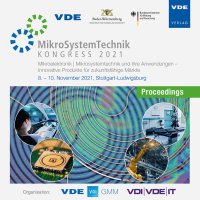Reliability Aspects of in-plane NED Bending Actuators in Silicon-based MEMS
Conference: MikroSystemTechnik Kongress 2021 - Kongress
11/08/2021 - 11/10/2021 at Stuttgart-Ludwigsburg, Deutschland
Proceedings: MikroSystemTechnik Kongress 2021
Pages: 4Language: englishTyp: PDF
Authors:
Stolz, Michael; Langa, Sergiu; Kaiser, Bert (Fraunhofer Institute for Photonic Microsystems IPMS, Dresden, Germany)
Schenk, Harald (Fraunhofer Institute for Photonic Microsystems IPMS, Dresden, Germany & Brandenburg University of Technology Cottbus-Senftenberg, Cottbus, Germany)
Abstract:
For several years, Fraunhofer IPMS has been developing a new type of an electrostatic MEMS actuator, called nanoscopic electrostatic drive - NED. Since the first publication in 2015, the project group at IPMS has succeeded in providing lateral actuators, which serve as innovative drives in applications such as micro-positioners or micro-speakers. These applications require a high long-term stability of the drive in order to ensure that the system operates as desired. For this purpose, the reliability of such novel lateral electrostatic actuators was evaluated. Long-term studies of NED actuators have shown that different degradation phenomena can occur during operation. The experiments indicate that high electric fields in the range of several MV/m are one of the most important triggers of the degradations observed. On the one hand, they lead to anodic oxidation occurring at the boundary layers between the NED electrodes and neighbored insulators, which results in corrosion of the silicon electrodes. On the other hand, geometry-based field enhancement far from the insulator interfaces lead to permanent field emission, which causes dark discharges in the electrode gap. This in turn leads to cold plasma oxidation and the growth of oxide b ulges on the electrode surfaces. In the course of the experiments, it was shown that corrosion does not take place in a vacuum and can be avoided with the help of passivation layers. Non silicon oxides, e.g. Al2O3, are well suited as passivation layers. Although they bring additional flexural rigidity to the overall structure, which changes the mechanical behavior of the actuators, they increase the effective relative permittivity in the electrode gap, which in turn makes the actuators more effective. Thanks to the passivation coating,the lifespan of the NED actuators was increased and they can become even more effective by choosing a layer with suitable properties.


